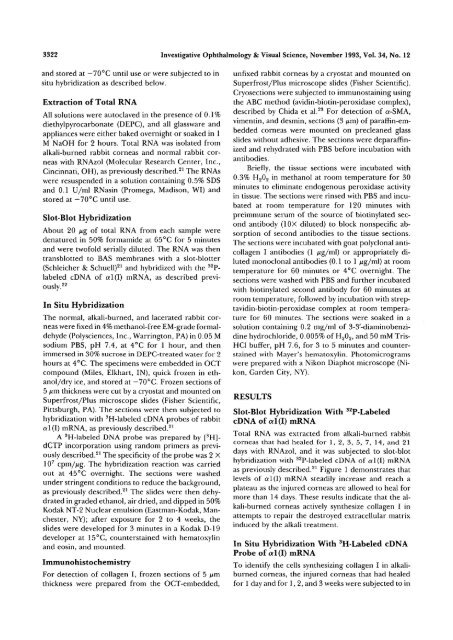Expression of Collagen I, Smooth Muscle a-Actin, and Vimentin ...
Expression of Collagen I, Smooth Muscle a-Actin, and Vimentin ...
Expression of Collagen I, Smooth Muscle a-Actin, and Vimentin ...
Create successful ePaper yourself
Turn your PDF publications into a flip-book with our unique Google optimized e-Paper software.
3322 Investigative Ophthalmology & Visual Science, November 1993, Vol. 34, No. 12<br />
<strong>and</strong> stored at — 70°C until use or were subjected to in<br />
situ hybridization as described below.<br />
Extraction <strong>of</strong> Total RNA<br />
All solutions were autoclaved in the presence <strong>of</strong> 0.1%<br />
diethylpyrocarbonate (DEPC), <strong>and</strong> all glassware <strong>and</strong><br />
appliances were either baked overnight or soaked in 1<br />
M NaOH for 2 hours. Total RNA was isolated from<br />
alkali-burned rabbit corneas <strong>and</strong> normal rabbit corneas<br />
with RNAzol (Molecular Research Center, Inc.,<br />
Cincinnati, OH), as previously described. 21 The RNAs<br />
were resuspended in a solution containing 0.5% SDS<br />
<strong>and</strong> 0.1 U/ml RNasin (Promega, Madison, WI) <strong>and</strong><br />
stored at —70°C until use.<br />
Slot-Blot Hybridization<br />
About 20 fig <strong>of</strong> total RNA from each sample were<br />
denatured in 50% formamide at 65°C for 5 minutes<br />
<strong>and</strong> were tw<strong>of</strong>old serially diluted. The RNA was then<br />
transblotted to BAS membranes with a slot-blotter<br />
(Schleicher & Schuell) 21 <strong>and</strong> hybridized with the 32 P-<br />
labeled cDNA <strong>of</strong> a 1(1) mRNA, as described previously.<br />
22<br />
In Situ Hybridization<br />
The normal, alkali-burned, <strong>and</strong> lacerated rabbit corneas<br />
were fixedin 4% methanol-free EM-grade formaldehyde<br />
(Polysciences, Inc., Warrington, PA) in 0.05 M<br />
sodium PBS, pH 7.4, at 4°C for 1 hour, <strong>and</strong> then<br />
immersed in 30% sucrose in DEPC-treated water for 2<br />
hours at 4°C. The specimens were embedded in OCT<br />
compound (Miles, Elkhart, IN), quick frozen in ethanol/dry<br />
ice, <strong>and</strong> stored at -70°C. Frozen sections <strong>of</strong><br />
5 fim thickness were cut by a cryostat <strong>and</strong> mounted on<br />
Superfrost/Plus microscope slides (Fisher Scientific,<br />
Pittsburgh, PA). The sections were then subjected to<br />
hybridization with 3 H-labeled cDNA probes <strong>of</strong> rabbit<br />
al(I) mRNA, as previously described. 21<br />
A 3 H-labeled DNA probe was prepared by [ 3 H]-<br />
dCTP incorporation using r<strong>and</strong>om primers as previously<br />
described. 21 The specificity <strong>of</strong> the probe was 2 X<br />
10 7 cpm/fxg. The hybridization reaction was carried<br />
out at 45°C overnight. The sections were washed<br />
under stringent conditions to reduce the background,<br />
as previously described. 21 The slides were then dehydrated<br />
in graded ethanol, air dried, <strong>and</strong> dipped in 50%<br />
Kodak NT-2 Nuclear emulsion (Eastman-Kodak, Manchester,<br />
NY); after exposure for 2 to 4 weeks, the<br />
slides were developed for 3 minutes in a Kodak D-19<br />
developer at 15°C, counterstained with hematoxylin<br />
<strong>and</strong> eosin, <strong>and</strong> mounted.<br />
Immunohistochemistry<br />
For detection <strong>of</strong> collagen I, frozen sections <strong>of</strong> 5 /um<br />
thickness were prepared from the OCT-embedded,<br />
unfixed rabbit corneas by a cryostat <strong>and</strong> mounted on<br />
Superfrost/Plus microscope slides (Fisher Scientific).<br />
Cryosections were subjected to immunostaining using<br />
the ABC method (avidin-biotin-peroxidase complex),<br />
described by Chida et al. 23 For detection <strong>of</strong> a-SMA,<br />
vimentin, <strong>and</strong> desmin, sections (3 /xm) <strong>of</strong> paraffin-embedded<br />
corneas were mounted on precleaned glass<br />
slides without adhesive. The sections were deparaffinized<br />
<strong>and</strong> rehydrated with PBS before incubation with<br />
antibodies.<br />
Briefly, the tissue sections were incubated with<br />
0.3% H 2 0 2 in methanol at room temperature for 30<br />
minutes to eliminate endogenous peroxidase activity<br />
in tissue. The sections were rinsed with PBS <strong>and</strong> incubated<br />
at room temperature for 120 minutes with<br />
preimmune serum <strong>of</strong> the source <strong>of</strong> biotinylated second<br />
antibody (10X diluted) to block nonspecific absorption<br />
<strong>of</strong> second antibodies to the tissue sections.<br />
The sections were incubated with goat polyclonal anticollagen<br />
I antibodies (1 jug/ml) or appropriately diluted<br />
monoclonal antibodies (0.1 to 1 jig/ml) at room<br />
temperature for 60 minutes or 4°C overnight. The<br />
sections were washed with PBS <strong>and</strong> further incubated<br />
with biotinylated second antibody for 60 minutes at<br />
room temperature, followed by incubation with streptavidin-biotin-peroxidase<br />
complex at room temperature<br />
for 60 minutes. The sections were soaked in a<br />
solution containing 0.2 mg/ml <strong>of</strong> 3-3'-diaminobenzidine<br />
hydrochloride, 0.005% <strong>of</strong> H 2 0 2 , <strong>and</strong> 50 mM Tris-<br />
HC1 buffer, pH 7.6, for 3 to 5 minutes <strong>and</strong> counterstained<br />
with Mayer's hematoxylin. Photomicrograms<br />
were prepared with a Nikon Diaphot microscope (Nikon,<br />
Garden City, NY).<br />
RESULTS<br />
Slot-Blot Hybridization With 32 P-Labeled<br />
cDNA<strong>of</strong>al(I)mRNA<br />
Total RNA was extracted from alkali-burned rabbit<br />
corneas that had healed for 1, 2, 3, 5, 7, 14, <strong>and</strong> 21<br />
days with RNAzol, <strong>and</strong> it was subjected to slot-blot<br />
hybridization with 32 P-labeled cDNA <strong>of</strong> a 1(1) mRNA<br />
as previously described. 21 Figure 1 demonstrates that<br />
levels <strong>of</strong> a 1(1) mRNA steadily increase <strong>and</strong> reach a<br />
plateau as the injured corneas are allowed to heal for<br />
more than 14 days. These results indicate that the alkali-burned<br />
corneas actively synthesize collagen I in<br />
attempts to repair the destroyed extracellular matrix<br />
induced by the alkali treatment.<br />
In Situ Hybridization With 3 H-Labeled cDNA<br />
Probe <strong>of</strong> al (I) mRNA<br />
To identify the cells synthesizing collagen I in alkaliburned<br />
corneas, the injured corneas that had healed<br />
for 1 day <strong>and</strong> for 1,2, <strong>and</strong> 3 weeks were subjected to in
















